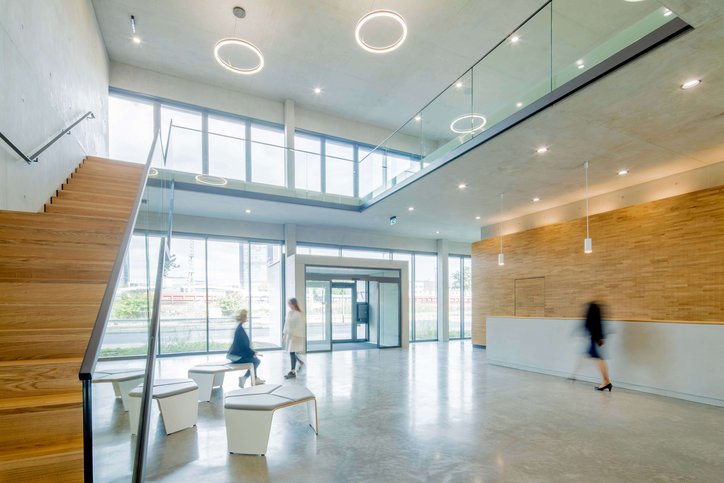01.04.2024
Research projects
High-quality recycling of crushed concrete sand
In the ZIM research project, used concrete is processed in such a way as to improve the usability of all fractions generated, in particular the crushed sand and the fine fraction. To this end, tests are also being carried out on the pozzolanic reactivation of the recycled concrete fines.
Learn more
01.07.2024
Research projects
Systematic application of IR spectroscopy to strengthen the circular economy in the construction industry
In this research project, IR spectroscopy in combination with mathematical tools (chemometrics) is going to be evaluated as an analytical method for the characterisation of silica based materials, primarily X-ray amorphous materials, with regard to the reliable determination of the composition of material mixtures with X-ray amorphous materials (e.g. ternary cements with calcined clay and/or recycled concrete fines). In a next step, the findings on the analytical method and evaluation routines developed for cement are going to be evaluated with regard to their transferability to siliceous aggregates for estimating its alkali sensitivity.
Learn more
01.07.2024
Research projects
Performance of ternary cements with Portland cement clinker, calcined clay and limestone as the main constituents
The project systematically investigates the performance and hydration behaviour of ternary cement (KQL) with clinker (K), calcined clay (Q) and limestone (L) as well as key durability aspects of concretes produced with these materials.
Learn more
01.05.2024
Research projects
Process atmosphere during clay calcination – effects on emissions and product properties
Calcined clays as the main cement constituent are an essential part of the cement industry's decarbonisation strategy. Many clay deposits have iron-rich impurities that form hematite during calcination, which colors the product, the cement and ultimately the concrete red. A reducing atmosphere during calcination and/or cooling can prevent the formation of hematite.
Systematic findings on the influence of secondary constituents in clays on their reactivity, emissions and cement-technical properties have hardly been available to date and are to be systematically investigated in the project.
Learn more
27.01.2026
Training
Advanced cement chemistry: use of alternative raw materials and fuels
In this advanced seminar, you will look at the current challenges facing cement chemistry in terms of resource efficiency and climate neutrality. The focus will be on the use of alternative raw materials and fuels in clinker production. You will learn about the origin, composition and properties of these materials and understand their influence on the clinker burning process. You will also be introduced to modern methods of clinker analysis to assess the effect of alternative raw materials and fuels on cement properties. Finally, you will discuss the hydration behaviour of complex composite cements and quality assurance methods in a practical way.
Learn more
25.11.2025
Training
Basics of cement chemistry
This seminar will give you a practical overview of the fundamentals of cement chemistry and the main product properties. You will learn about the origin, composition and properties of the raw materials used in the production of Portland cement clinker and cement, and understand the chemical reactions that take place during the clinker burning process. We will show you how clinker is characterised and what factors influence its properties. The hydration reactions of Portland cements and cements with other main constituents will also be covered. You will learn methods for cement characterisation and production control during the seminar.
Learn more
01.09.2022
Research projects
X-ray analysis for production control of cements with calcined clays
The subject of the IGF research project 22502 N is the application of X-ray diffraction analysis for production and quality control of calcined clays and cements produced with them, in order to accelerate the development of cements with further reduced clinker content within the framework of the decarbonisation of the cement industry.
Learn more
01.09.2022
Research projects
Elution of fresh concrete – determination concept
The IGF research project 22330 N is concerned with the environmental compatibility of cement-bound building materials in special application situations in which the binder comes into contact with groundwater during the processing phase. A procedure is being developed to demonstrate the environmental compatibility of the building materials in these situations as well.
Learn more
01.07.2021
Research projects
Clinker burning with alternative fuels at low process temperatures - effects on coating formation and on the corrosion of refractory products in the cement rotary kiln as well as on the performance of cement
The replacement of primary fuels by alternative fuels is of great economic and ecological importance for the cement industry and is to be increased in the future. The fuel ashes are used as raw material in the cement clinker and influence its properties as well as the coating formation on the refractory lining in the kiln. Exact knowledge of these effects is indispensable for the further increase of the alternative fuel rate and the simultaneous optimisation of the kiln operation as well as for the maintenance of the clinker quality and the service life of the refractory lining.
Learn more
01.02.2022
Research projects
Setting control with recycled gypsum
The possibilities and limits of using RC gypsum for cement production have been determined. The findings will help to compensate for the future elimination of FGD gypsum, conserve natural resources and reduce the amount of waste going to landfill.
Learn more




